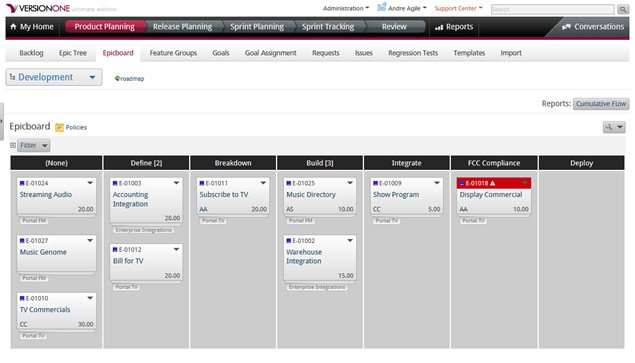Abstract
Agile methods create conflict. So to retain agility, we must actively promote it even after agile has taken hold. How can we equip a company with the cultural and process tools to sustain agility? Your choices may depend on your perspective. Social psychologists teach organizations to reinvent themselves, but this approach may be too slow for a large company. Change agents study, develop and evangelize specific processes, a more promising approach. “Adaptive portfolio management” is a specific process under development that may help sustain agile-thinking. It maximizes value by rapidly adapting to market and company changes. In using adaptive portfolio management, company leaders exercise agile fundamentals. They can become agile advocates for the whole organization, making agility more stable for developers on the ground.
In the service of productivity, agile methods create conflict. Consider continuous improvement, a canon of agility: It demands that people expose perceived problems and analyze their causes. Try it in any relationship, and you’ll create conflict. Agile techniques increase transparency, increase accountability, weaken mid-level managers and deemphasize heroism: just a few more things that make some people mad. Some may start to see agile as the problem. “It was so much easier the old way!”
And so, agile culture requires active support even after it seems to take hold. Many experienced coaches have seen organizations that successfully implemented Scrum, and then stumbled. Some conclude this arises from software development’s nature as a complex system. Scrum seeks to lightly control the chaos of software development—allowing for innovation while ensuring productivity; its feedback-driven control requires intellectual energy to sustain.
How can we equip a company with the cultural and process tools to sustain agility? The 2011 Scrum Coaching Retreat brought 70 Scrum coaches together in Boulder, Colorado Dec 7-9 to focus on this. We formed groups to analyse different elements of the problem.
Social psychologists and change agents
How we help a company sustain agile practices depends on our perspective. Some coaches are social psychologists—fostering agile culture and teaching organizations to reinvent themselves; others are change agents—studying, developing and evangelizing specific processes. I’m a change agent by nature.
I love analyzing and designing whole-company processes. The Agile Organization Design group seemed promising: it might have proposed ways to design organizations to support agile principles. However, social psychologists in the group challenged the presumption that we might design organizations at all. They sought strategies to enable an agile organization to design itself. One suggested that we “Fire all the managers.” Another wanted the organization to “self organize”. Self-organization takes a long time for Scrum teams, and much longer for large companies. As a result, leaders largely design companies by fiat. The change agents among us wanted to help those leaders, documenting organization designs that had worked for others, providing templates they might use as a starting point. The group made no progress; our goals were too different. I switched groups.
Adaptive Portfolio Management
The Adaptive Portfolio Management group provided a refreshing harmony, with like-minded folks seeking the best ways to prioritize, staff, interrupt and cancel projects. The group established a definition:
Adaptive Portfolio Management is the discipline of regularly changing the priority of business initiatives and resource commitments to maximize total portfolio return. This is implemented by:
- Creating and managing an inventory of strategic initiatives
- Prioritizing initiatives based on business drivers
- Allocating budget to initiatives to maximize value
- Periodically re-evaluating allocations based on changing needs
- Transparently communicating across the organization
and a credo (really a manifesto, mimicking the format of the Agile Manifesto:)
We value:
- Optimizing the holistic portfolio over Protecting departmental budgets
- Courage to change over Following a plan
- Ability to evaluate the portfolio on a frequent basis over Infrequent (i.e. annual) planning cycles
- Responding to emerging opportunities over Sticking to the plan
- Maximizing value over Managing cost
- Collaborating on decisions over Centralized authority
I was excited that 12 experienced people agreed on fundamental principles and worked so productively together. I was relieved that a portfolio management technique we developed at Citrix Online fulfilled the group’s principles [gree2010]. We tried out an adaptive portfolio management game, developed by group member Jade Meskill [mesk2011]. In playing this game, competing teams largely developed the same risk-adjusted profit-maximizing strategies to order portfolio backlogs. We thought alike! Many of the graphics developed by the group would be suitable to describe Enterprise Scrum [scrp2011].
While adaptive portfolio management helps maximize a company’s profitability, it can also help sustain a company’s agile thinking and processes. If key decisions on project funding and prioritization are based on agile principles, those principles become infused in the corporate culture. Executives often own major product decisions. If those executives are using adaptive portfolio management, the rest of the company is likely to follow their lead and support other agile activities.
My colleagues and I are studying and developing better approaches for company-wide agile methods. We help companies become agile and stay that way. Please contact me if the topic area interests you.
References
- [gree2010]
- Daniel Greening, “Enterprise Scrum: Scaling Scrum to the Enterprise Level,” 2010 43rd Hawaii International Conference on System Sciences (HICSS), Koloa, Kauai, Hawaii January 5-8, ISBN: 978-0-7695-3869-3 (10 pages)
- [mesk2011]
- Jade Meskill. Agile Portfolio Management Game. Description and downloadable game materials. Blog entry. 9 Dec 2011.
- [ries2011]
- Eric Ries. The Lean Startup: How Today’s Entrepreneurs Use Continuous Innovation to Create Radically Successful Businesses. Crown Business, 2011.
- [scrm2011]
- Scrum Coaching Retreat 2011, Boulder Colorado.
- [scrp2011]
- Adaptive Portfolio Management, Scrum Coaching Retreat 2011, Boulder Colorado.





Leave a Reply
You must be logged in to post a comment.